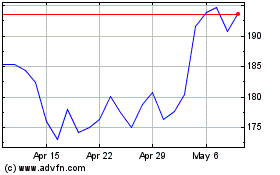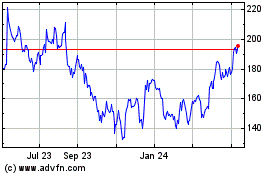First Solar: Expects Feed-In-Tariff Soon For 2GW China Plant
November 17 2009 - 4:15AM
Dow Jones News
Electricity from First Solar Inc.'s (FSLR) planned 2-gigawatt
solar power plant in China's Inner Mongolia will likely be priced
via a feed-in tariff structure which hopefully will be set by the
end of 2009, a senior official with the U.S. company said
Tuesday.
"The Chinese government is considering a feed-in tariff
structure. We are certainly expecting that the feed-in-tariff will
be enacted and are hoping it will be so before the end of this
year," First Solar president Bruce Sohn told a media briefing.
He said the tariff level was "critical to the success of this
project."
"Feed-in tariffs establish transparency and clarity for the
pricing of energy for a long period of time."
China for now sets solar tariffs on a case-by-case basis, and in
most cases project developers can only get clarity over tariffs
well after construction has started, increasing investment
risk.
The Beijing government has said it is studying a fixed feed-in
tariff system, but details haven't been made public yet.
One of the largest solar photovoltaic projects to date, the
First Solar project will be built in stages, beginning with 30
megawatts in phase one, construction of which will start in
2010.
The capacities of phases two, three and four are to be 100MW,
870MW and 1,000MW respectively. The second and third stages are due
for completion by 2014, and the fourth is due to be ready by
2019.
The First Solar project is one of a number of China-U.S. joint
ventures in the solar sector announced recently.
On Oct. 26, Duke Energy (DUK) said it had signed an agreement
with Chinese energy company and solar panel maker ENN Group to
develop, own and operate solar-power projects in the U.S.
Sohn said the cost of the First Solar project, to be built in
Ordos City beginning in June, hasn't been finalized, but will be
"somewhat lower" than the $4 billion to $5 billion that a similar
project would cost if built in the U.S.
In August, China set the feed-in tariff for its first commercial
solar utility project at CNY1.09 per kilowatt hour, and this may
set a benchmark for future projects.
As the Chinese government's policy on solar power develops,
demand for solar modules should grow, Sohn said.
"First Solar views China as potentially a very large and
significant market," Sohn said. "We do anticipate that the market
will continue to grow."
"The movement toward more assertive goals, the movement toward
introducing a feed-in tariff in the near future...should create a
sustainable and vibrant solar industry," he said.
Beijing has a target of 300 MW of annual solar power generation
capacity by 2010 and as much as 20 gigawatts by 2020, but as of
end-2008 capacity was under 100MW.
In July, China gave its fledgling solar power industry a boost
by announcing construction subsidies for on-grid solar power
plants.
On Monday, the Ministry of Finance said China will spend over
CNY20 billion to subsidize 642 MW of pilot solar utility projects
in the next two-three years.
Sohn also said the Tempe, Ariz., company may consider setting up
manufacturing facilities in China.
"China is a very viable location," he said. "As we see the
market develop and mature here, this seems like a very appropriate
place to manufacture."
First Solar sources materials for portions of its supply chain
outside China, he said.
Sohn was in Beijing to sign an agreement firming up details of
the project, which was announced in September.
-By Patricia Jiayi Ho, Dow Jones Newswires; (8610) 6588 5848;
patricia.ho@dowjones.com
First Solar (NASDAQ:FSLR)
Historical Stock Chart
From Mar 2024 to Apr 2024

First Solar (NASDAQ:FSLR)
Historical Stock Chart
From Apr 2023 to Apr 2024
